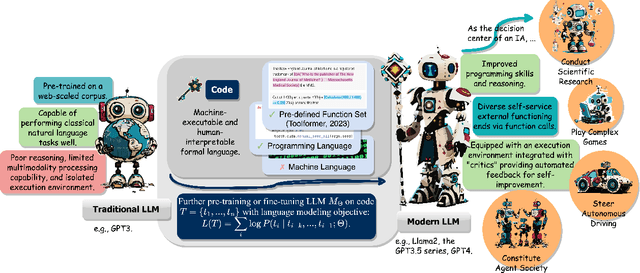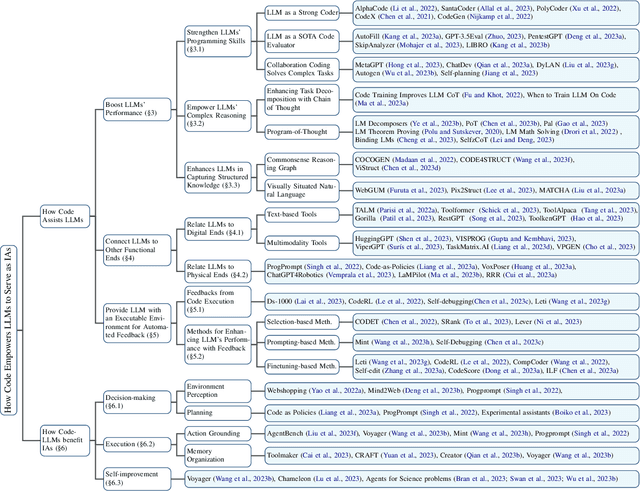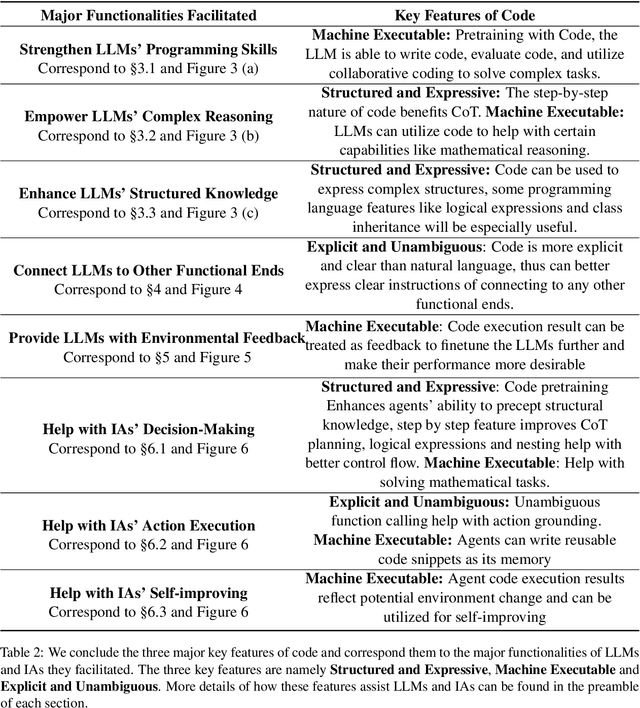Yi R. Fung
TAMP: Token-Adaptive Layerwise Pruning in Multimodal Large Language Models
Apr 15, 2025Abstract:Multimodal Large Language Models (MLLMs) have shown remarkable versatility in understanding diverse multimodal data and tasks. However, these capabilities come with an increased model scale. While post-training pruning reduces model size in unimodal models, its application to MLLMs often yields limited success. Our analysis discovers that conventional methods fail to account for the unique token attributes across layers and modalities inherent to MLLMs. Inspired by this observation, we propose TAMP, a simple yet effective pruning framework tailored for MLLMs, featuring two key components: (1) Diversity-Aware Sparsity, which adjusts sparsity ratio per layer based on diversities among multimodal output tokens, preserving more parameters in high-diversity layers; and (2) Adaptive Multimodal Input Activation, which identifies representative multimodal input tokens using attention scores to guide unstructured weight pruning. We validate our method on two state-of-the-art MLLMs: LLaVA-NeXT, designed for vision-language tasks, and VideoLLaMA2, capable of processing audio, visual, and language modalities. Empirical experiments across various multimodal evaluation benchmarks demonstrate that each component of our approach substantially outperforms existing pruning techniques.
Scaling Laws of Synthetic Data for Language Models
Mar 26, 2025Abstract:Large language models (LLMs) achieve strong performance across diverse tasks, largely driven by high-quality web data used in pre-training. However, recent studies indicate this data source is rapidly depleting. Synthetic data emerges as a promising alternative, but it remains unclear whether synthetic datasets exhibit predictable scalability comparable to raw pre-training data. In this work, we systematically investigate the scaling laws of synthetic data by introducing SynthLLM, a scalable framework that transforms pre-training corpora into diverse, high-quality synthetic datasets. Our approach achieves this by automatically extracting and recombining high-level concepts across multiple documents using a graph algorithm. Key findings from our extensive mathematical experiments on SynthLLM include: (1) SynthLLM generates synthetic data that reliably adheres to the rectified scaling law across various model sizes; (2) Performance improvements plateau near 300B tokens; and (3) Larger models approach optimal performance with fewer training tokens. For instance, an 8B model peaks at 1T tokens, while a 3B model requires 4T. Moreover, comparisons with existing synthetic data generation and augmentation methods demonstrate that SynthLLM achieves superior performance and scalability. Our findings highlight synthetic data as a scalable and reliable alternative to organic pre-training corpora, offering a viable path toward continued improvement in model performance.
MimeQA: Towards Socially-Intelligent Nonverbal Foundation Models
Feb 23, 2025Abstract:Socially intelligent AI that can understand and interact seamlessly with humans in daily lives is increasingly important as AI becomes more closely integrated with peoples' daily activities. However, current works in artificial social reasoning all rely on language-only, or language-dominant approaches to benchmark and training models, resulting in systems that are improving in verbal communication but struggle with nonverbal social understanding. To address this limitation, we tap into a novel source of data rich in nonverbal and social interactions -- mime videos. Mimes refer to the art of expression through gesture and movement without spoken words, which presents unique challenges and opportunities in interpreting non-verbal social communication. We contribute a new dataset called MimeQA, obtained by sourcing 221 videos from YouTube, through rigorous annotation and verification, resulting in a benchmark with 101 videos and 806 question-answer pairs. Using MimeQA, we evaluate state-of-the-art video large language models (vLLMs) and find that their overall accuracy ranges from 15-30%. Our analysis reveals that vLLMs often fail to ground imagined objects and over-rely on the text prompt while ignoring subtle nonverbal interactions. Our data resources are released at https://github.com/MIT-MI/MimeQA to inspire future work in foundation models that embody true social intelligence capable of interpreting non-verbal human interactions.
The Law of Knowledge Overshadowing: Towards Understanding, Predicting, and Preventing LLM Hallucination
Feb 22, 2025



Abstract:Hallucination is a persistent challenge in large language models (LLMs), where even with rigorous quality control, models often generate distorted facts. This paradox, in which error generation continues despite high-quality training data, calls for a deeper understanding of the underlying LLM mechanisms. To address it, we propose a novel concept: knowledge overshadowing, where model's dominant knowledge can obscure less prominent knowledge during text generation, causing the model to fabricate inaccurate details. Building on this idea, we introduce a novel framework to quantify factual hallucinations by modeling knowledge overshadowing. Central to our approach is the log-linear law, which predicts that the rate of factual hallucination increases linearly with the logarithmic scale of (1) Knowledge Popularity, (2) Knowledge Length, and (3) Model Size. The law provides a means to preemptively quantify hallucinations, offering foresight into their occurrence even before model training or inference. Built on overshadowing effect, we propose a new decoding strategy CoDa, to mitigate hallucinations, which notably enhance model factuality on Overshadow (27.9%), MemoTrap (13.1%) and NQ-Swap (18.3%). Our findings not only deepen understandings of the underlying mechanisms behind hallucinations but also provide actionable insights for developing more predictable and controllable language models.
Knowledge Overshadowing Causes Amalgamated Hallucination in Large Language Models
Jul 10, 2024Abstract:Hallucination is often regarded as a major impediment for using large language models (LLMs), especially for knowledge-intensive tasks. Even when the training corpus consists solely of true statements, language models still generate hallucinations in the form of amalgamations of multiple facts. We coin this phenomenon as ``knowledge overshadowing'': when we query knowledge from a language model with multiple conditions, some conditions overshadow others, leading to hallucinated outputs. This phenomenon partially stems from training data imbalance, which we verify on both pretrained models and fine-tuned models, over a wide range of LM model families and sizes.From a theoretical point of view, knowledge overshadowing can be interpreted as over-generalization of the dominant conditions (patterns). We show that the hallucination rate grows with both the imbalance ratio (between the popular and unpopular condition) and the length of dominant condition description, consistent with our derived generalization bound. Finally, we propose to utilize overshadowing conditions as a signal to catch hallucination before it is produced, along with a training-free self-contrastive decoding method to alleviate hallucination during inference. Our proposed approach showcases up to 82% F1 for hallucination anticipation and 11.2% to 39.4% hallucination control, with different models and datasets.
MACAROON: Training Vision-Language Models To Be Your Engaged Partners
Jun 20, 2024Abstract:Large vision-language models (LVLMs), while proficient in following instructions and responding to diverse questions, invariably generate detailed responses even when questions are ambiguous or unanswerable, leading to hallucinations and bias issues. Thus, it is essential for LVLMs to proactively engage with humans to ask for clarifications or additional information for better responses. In this study, we aim to shift LVLMs from passive answer providers to proactive engaged partners. We begin by establishing a three-tiered hierarchy for questions of invalid, ambiguous, and personalizable nature to measure the proactive engagement capabilities of LVLMs. Utilizing this hierarchy, we create PIE, (ProactIve Engagement Evaluation) through GPT-4o and human annotators, consisting of 853 questions across six distinct, fine-grained question types that are verified by human annotators and accompanied with well-defined metrics. Our evaluations on \benchmark indicate poor performance of existing LVLMs, with the best-performing open-weights model only achieving an Aggregate Align Rate (AAR) of 0.28. In response, we introduce MACAROON, self-iMaginAtion for ContrAstive pReference OptimizatiON, which instructs LVLMs to autonomously generate contrastive response pairs for unlabeled questions given the task description and human-crafted criteria. Then, the self-imagined data is formatted for conditional reinforcement learning. Experimental results show MACAROON effectively improves LVLMs' capabilities to be proactively engaged (0.84 AAR) while maintaining comparable performance on general tasks.
From Pixels to Insights: A Survey on Automatic Chart Understanding in the Era of Large Foundation Models
Mar 25, 2024Abstract:Data visualization in the form of charts plays a pivotal role in data analysis, offering critical insights and aiding in informed decision-making. Automatic chart understanding has witnessed significant advancements with the rise of large foundation models in recent years. Foundation models, such as large language models, have revolutionized various natural language processing tasks and are increasingly being applied to chart understanding tasks. This survey paper provides a comprehensive overview of the recent developments, challenges, and future directions in chart understanding within the context of these foundation models. We review fundamental building blocks crucial for studying chart understanding tasks. Additionally, we explore various tasks and their evaluation metrics and sources of both charts and textual inputs. Various modeling strategies are then examined, encompassing both classification-based and generation-based approaches, along with tool augmentation techniques that enhance chart understanding performance. Furthermore, we discuss the state-of-the-art performance of each task and discuss how we can improve the performance. Challenges and future directions are addressed, highlighting the importance of several topics, such as domain-specific charts, lack of efforts in developing evaluation metrics, and agent-oriented settings. This survey paper serves as a comprehensive resource for researchers and practitioners in the fields of natural language processing, computer vision, and data analysis, providing valuable insights and directions for future research in chart understanding leveraging large foundation models. The studies mentioned in this paper, along with emerging new research, will be continually updated at: https://github.com/khuangaf/Awesome-Chart-Understanding.
LEMMA: Towards LVLM-Enhanced Multimodal Misinformation Detection with External Knowledge Augmentation
Feb 19, 2024Abstract:The rise of multimodal misinformation on social platforms poses significant challenges for individuals and societies. Its increased credibility and broader impact compared to textual misinformation make detection complex, requiring robust reasoning across diverse media types and profound knowledge for accurate verification. The emergence of Large Vision Language Model (LVLM) offers a potential solution to this problem. Leveraging their proficiency in processing visual and textual information, LVLM demonstrates promising capabilities in recognizing complex information and exhibiting strong reasoning skills. In this paper, we first investigate the potential of LVLM on multimodal misinformation detection. We find that even though LVLM has a superior performance compared to LLMs, its profound reasoning may present limited power with a lack of evidence. Based on these observations, we propose LEMMA: LVLM-Enhanced Multimodal Misinformation Detection with External Knowledge Augmentation. LEMMA leverages LVLM intuition and reasoning capabilities while augmenting them with external knowledge to enhance the accuracy of misinformation detection. Our method improves the accuracy over the top baseline LVLM by 7% and 13% on Twitter and Fakeddit datasets respectively.
Persona-DB: Efficient Large Language Model Personalization for Response Prediction with Collaborative Data Refinement
Feb 16, 2024Abstract:The increasing demand for personalized interactions with large language models (LLMs) calls for the development of methodologies capable of accurately and efficiently identifying user opinions and preferences. Retrieval augmentation emerges as an effective strategy, as it can accommodate a vast number of users without the costs from fine-tuning. Existing research, however, has largely focused on enhancing the retrieval stage and devoted limited exploration toward optimizing the representation of the database, a crucial aspect for tasks such as personalization. In this work, we examine the problem from a novel angle, focusing on how data can be better represented for more efficient retrieval in the context of LLM customization. To tackle this challenge, we introduce Persona-DB, a simple yet effective framework consisting of a hierarchical construction process to improve generalization across task contexts and collaborative refinement to effectively bridge knowledge gaps among users. In the task of response forecasting, Persona-DB demonstrates superior efficiency in maintaining accuracy with a significantly reduced retrieval size, a critical advantage in scenarios with extensive histories or limited context windows. Our experiments also indicate a marked improvement of over 15% under cold-start scenarios, when users have extremely sparse data. Furthermore, our analysis reveals the increasing importance of collaborative knowledge as the retrieval capacity expands.
If LLM Is the Wizard, Then Code Is the Wand: A Survey on How Code Empowers Large Language Models to Serve as Intelligent Agents
Jan 08, 2024



Abstract:The prominent large language models (LLMs) of today differ from past language models not only in size, but also in the fact that they are trained on a combination of natural language and formal language (code). As a medium between humans and computers, code translates high-level goals into executable steps, featuring standard syntax, logical consistency, abstraction, and modularity. In this survey, we present an overview of the various benefits of integrating code into LLMs' training data. Specifically, beyond enhancing LLMs in code generation, we observe that these unique properties of code help (i) unlock the reasoning ability of LLMs, enabling their applications to a range of more complex natural language tasks; (ii) steer LLMs to produce structured and precise intermediate steps, which can then be connected to external execution ends through function calls; and (iii) take advantage of code compilation and execution environment, which also provides diverse feedback for model improvement. In addition, we trace how these profound capabilities of LLMs, brought by code, have led to their emergence as intelligent agents (IAs) in situations where the ability to understand instructions, decompose goals, plan and execute actions, and refine from feedback are crucial to their success on downstream tasks. Finally, we present several key challenges and future directions of empowering LLMs with code.
 Add to Chrome
Add to Chrome Add to Firefox
Add to Firefox Add to Edge
Add to Edge